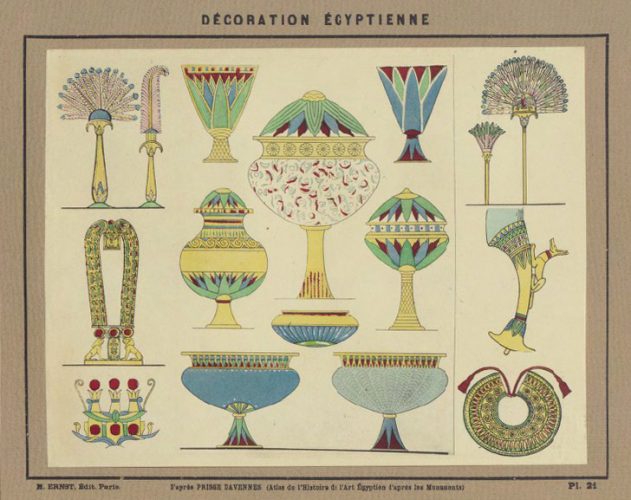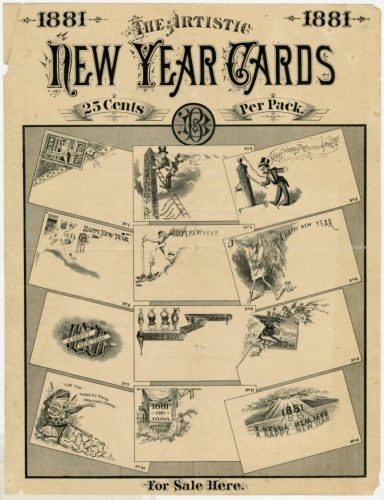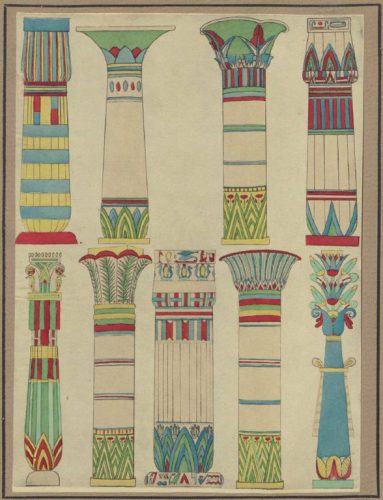Egyptomania!

In honor of the January 3, 1924, discovery of Tutankhamun’s sarcophagus in his tomb near Luxor, Egypt, today’s blog post features an item from the State Library of Ohio’s Rare Books Collection: Décoration égyptienne.

Ancient Egypt has fascinated the rest of the world for centuries. Romans incorporated Egyptian designs into their architecture and even worshiped Egyptian deities. Egyptomania—an intense interest in ancient Egypt—rose again during the Renaissance with the rediscovery of Classical writers such as Herodotus. Josiah Wedgewood used Egyptian-inspired designs in the mid-1700s, and Napoleon’s invasion of Egypt at the turn of the 19th century caused renewed interest across Europe in all things Egyptian. The opening of the Suez Canal and the installation of obelisks in London and New York fueled another wave of Egyptomania in the late 1800s.
Howard Carter and Lord Carnarvon’s discovery of Tutankhamun’s tomb in late 1922, along with the multi-year process of cataloging several thousand objects inside it, had an immediate cultural impact that lasted until World War II. Egyptian motifs appeared everywhere from fashion design to soap ads to wallpaper and influenced the Art Deco movement. Women wore dresses with Egyptian patterns in colors such as “blue lotus” and “mummy brown.” Cosmetics (including dark eyeliner) became one of the fastest-growing industries of the decade.
Décoration égyptienne is one of several design books published by Henri Ernst during the Egyptomania of the 1920s. It was created using the pochoir method, in which layers of color were hand painted using multiple stencils. (You can see another example of pochoir from the State Library’s collection here.) The illustrations show Egyptian design motifs inspired by 18th and 19th century sources.
Décoration égyptienne was published in France in 1923, shortly after the discovery of Tutankhamun’s tomb. Earlier this week, on January 1, works published in the United States in 1923 entered the public domain in the U.S. and are now free to use, perform, and adapt. (Because Décoration égyptienne was not published in the U.S., additional considerations apply.) Under current copyright law, this will continue on a rolling basis; works published in the U.S. in 1924 will enter the public domain on January 1, 2020; 1925 works on January 1, 2021; and so on.
Works new to the public domain this week include the silent film The Ten Commandments, produced and directed by Cecil B. DeMille (not the Charlton Heston version also directed by DeMille); New Hampshire by Robert Frost (which includes the poem “Stopping by Woods on a Snowy Evening”); and the musical London Calling! by Noel Coward (not the song by The Clash). Items in the State Library’s collection entering the public domain include The Life and Times of Tut-Ankh-Amen by Bishara Nahas (along with several other books about Tutankhamun and Egypt); the 1923 edition of The Boston Cooking-School Cook Book by Fannie Farmer; and Warren G. Harding: In Memoriam (published by the Seattle Press Club, where Harding, an Ohio native, made his last public appearance).
Wishing you a happy Public Domain Day and a happy New Year!
Thank you to Stephanie Michaels, Research and Catalog Services Librarian at the State Library of Ohio, for this week’s post!




Leave a Reply
You must be logged in to post a comment.